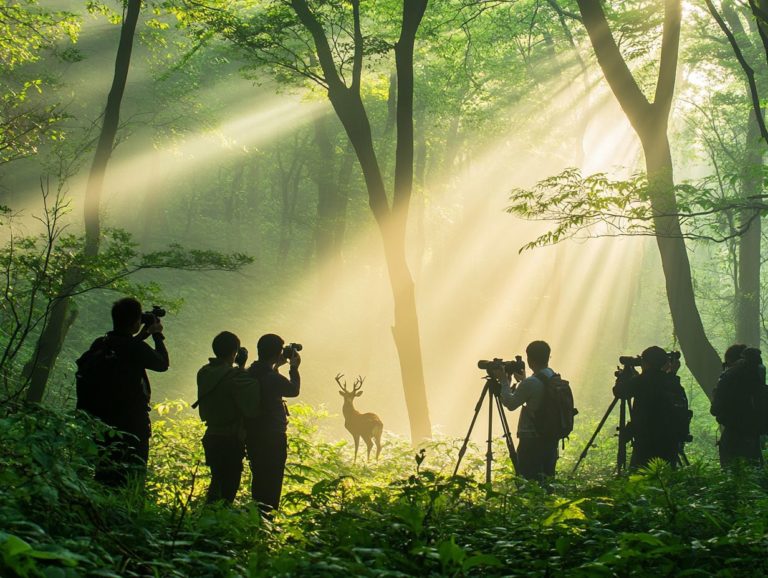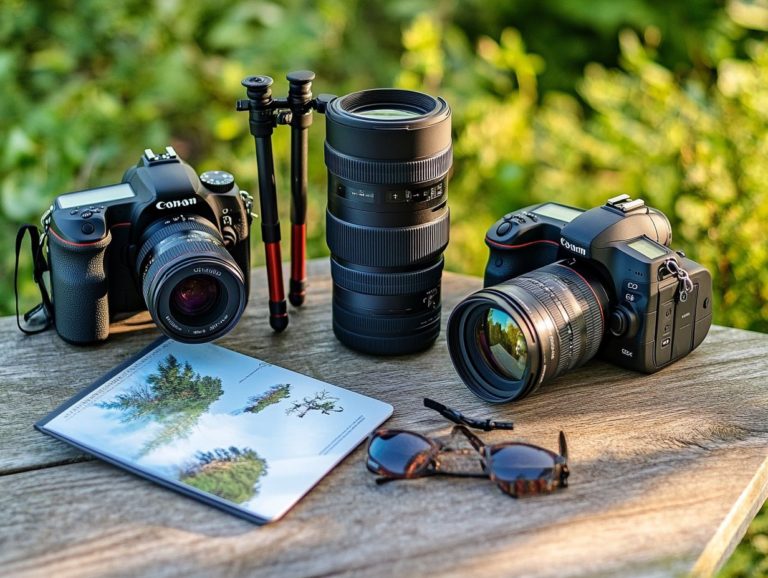The Importance of Patience in Bird Photography
Birdwatching and photography can be exhilarating pursuits, but they require a deep understanding of bird behavior and a respectful attitude toward their environment.
This exploration delves into the essential elements for capturing breathtaking images of birds. You’ll learn to observe their movements, anticipate their actions, and master the art of patience, which is key to success in this endeavor.
We ll also discuss the vital equipment you ll need, techniques for achieving perfect composition, and ethical considerations to ensure you respect both the birds and their habitats.
Get ready to elevate your bird photography skills!
Contents
- Key Takeaways:
- Mastering Bird Behavior for Stunning Photos
- Preparing for Bird Photography
- Patience in Bird Photography
- Capturing the Perfect Shot
- Respecting the Birds and Their Habitat
- Frequently Asked Questions
- What is the importance of patience in bird photography?
- How does patience affect the quality of bird photographs?
- Can patience lead to more opportunities for bird photography?
- How can one develop patience in bird photography?
- Is patience the only important factor in bird photography?
- How can patience be beneficial in other aspects of bird photography?
Key Takeaways:

- Patience is essential for catching the perfect shot.
- Understand bird behavior to anticipate their movements.
- Respecting wildlife ensures we can enjoy their beauty for years to come.
Mastering Bird Behavior for Stunning Photos
Understanding bird behavior is crucial for anyone interested in wildlife photography. It provides valuable insights into how birds interact with their surroundings, especially in fast-paced urban settings where behaviors can vary significantly.
By observing these patterns, photographers can learn to anticipate movements and capture stunning images of species such as American Robins, Bald Eagles, and Harlequin Ducks. This knowledge allows you to wait for that perfect moment, ensuring your shots have vibrant color and impeccable composition, whether you’re photographing in the Olympic Mountains or near the Strait of Juan de Fuca.
How to Observe and Predict Movements
To effectively observe and predict bird movements, you must develop a solid understanding of their behavior. This is essential for capturing those dynamic wildlife shots you desire.
Start by tracking various methods, such as monitoring feeding patterns. You ll often find birds foraging in specific areas at particular times. Pay attention to social interactions among different species; these interactions reveal valuable insights into their habits and routines.
Learning to interpret environmental cues, like shifts in weather or the presence of nearby predators, will significantly enhance your ability to anticipate bird activity. With patience and practice, these skills will not only improve your capacity to capture incredible photographs but also deepen your appreciation for the lives of these remarkable creatures.
Preparing for Bird Photography
Preparing for bird photography means carefully choosing the right equipment to ensure you re fully equipped to capture stunning images in diverse environments, including the urban jungles where wildlife can be elusive.
As a wildlife photographer, consider factors such as lens choice, camera settings, and portability. Adjust your selections based on whether you re exploring the majestic vistas of the Olympic Mountains or the vibrant scenes near Puget Sound.
Mastering various photography techniques is also crucial, as these skills will significantly enhance your ability to achieve the stunning results you seek.
Start your bird photography adventure today and capture breathtaking moments!
Essential Equipment and Techniques
Essential equipment for wildlife photography includes a sturdy camera, versatile lenses, and accessories that elevate your shooting experience. These tools allow you to document natural scenes as they unfold.
Investing in a quality telephoto lens, which allows you to zoom in on distant subjects, is crucial for capturing birds in their natural habitat. It helps you focus on intricate details without disturbing the subjects.
A solid tripod can greatly improve your stability, especially in low-light situations or when working with longer lenses. This ensures that your images remain sharp. Additionally, weather protection gear is invaluable for unpredictable conditions, safeguarding both your camera and lens from rain or dust.
By employing techniques such as patience and a keen understanding of bird behavior, you can seize spontaneous moments. This ultimately leads to stunning shots that beautifully convey the essence of avian life.
Patience in Bird Photography

Patience is undoubtedly one of the most essential virtues in bird photography. It often requires multiple sessions and significant time investment to finally capture that perfect shot of an enthralling wildlife scene.
As a wildlife photographer, you learn that success hinges on two key elements: waiting for the right moment and being ready for spontaneous actions. Whether you aim for a breathtaking sunset shot of Bald Eagles in flight or an exquisite capture of an American Robin foraging, the lesson is clear.
The most stunning photographs often emerge from long hours of anticipation and keen observation, rewarding your persistence with remarkable visual stories.
Why It Is Important
The significance of patience in bird photography is paramount, as it fundamentally shapes both the results and the quality of your captured images. Understanding the importance of timing in bird photography can greatly enhance your skills.
Taking the time to observe and understand avian behavior can greatly improve your chances of photographing striking scenes. Photographers often share thrilling stories about waiting quietly in a hidden spot, yielding breathtaking results unveiling intimate moments such as courtship displays or fledglings taking their first flights.
Research indicates that adopting a patient approach sharpens your ability to predict a bird’s movements and cultivates a deeper connection with nature. This transforms each outing into a rewarding adventure, elevating your experience beyond a mere pursuit of the perfect shot.
Tips for Practicing Patience
Practicing patience in bird photography can be enhanced through simple techniques such as meditation and breathing exercises. These practices help you remain calm and focused during long waits for the perfect shot.
Weaving mindfulness practices into your routine cultivates a deeper connection with your surroundings. Visualizing the breathtaking images you aim to capture fosters anticipation and promotes a tranquil mindset.
Engaging with nature, observing bird behavior, and savoring moments of stillness significantly enhance your capacity for patience. Setting realistic expectations and embracing the journey can further enrich this serene state, leading to photography sessions that reflect not just your skill but also a profound sense of serenity.
Capturing the Perfect Shot
Capturing the perfect shot demands a harmonious blend of composition, timing, and effective photography techniques. This is essential for any wildlife photographer who aspires to document the exquisite beauty of birds in their natural habitats.
Start practicing these techniques today and see your photography transform!
Composition and Timing
Mastering composition and timing is crucial for wildlife photography. These elements significantly influence the visual impact and narrative of your captured images.
Understanding compositional techniques like the rule of thirds, leading lines, and framing can elevate your photographs. They allow you to convey compelling stories about the natural world.
By utilizing these methods, you can highlight unique moments in wildlife, drawing the viewer’s eye directly to your subject.
The importance of timing whether capturing the soft light at dawn or the exhilarating energy of a chase deeply enhances the emotional resonance of your photographs.
Keep calm and use these strategies to capture that perfect shot. By melding thoughtful composition with precise timing, you can create images that are vibrant in color and rich in depth, effectively conveying the thrill and beauty of wildlife.
Dealing with Unexpected Situations

Dealing with unexpected situations during your wildlife photography sessions is an adventure. Experienced photographers can quickly adjust their methods to tackle any challenges that arise.
If a sudden downpour obscures visibility and threatens your equipment, seasoned wildlife photographers are always ready with weather-resistant gear and quick-drying cloths to safeguard their prized cameras.
When unpredictable wildlife behavior occurs like a herd of deer suddenly shifting direction because of a lurking predator you need to be agile and ready to pivot. A zoom lens a lens that lets you take close-up pictures from far away allows you to capture distant subjects without disrupting their natural environment.
By maintaining your composure and employing these strategies, capturing that perfect shot is not just possible but genuinely exhilarating.
Respecting the Birds and Their Habitat
Respecting the birds and their habitats is essential for wildlife photographers. Ethical considerations enhance your craft and play a crucial role in preserving the delicate balance of ecosystems while you capture breathtaking images.
Ethical Considerations
Understanding the possible effects your presence may have on bird habitats is vital. You must ensure that you don t cause undue disturbance.
Respecting the natural behavior of wildlife is essential. You should always maintain a safe distance and avoid using flash, as sudden bursts of light can startle or disorient birds, disrupting their mating or feeding routines.
Here are some best practices to keep in mind:
- Always observe wildlife from a safe distance.
- Use telephoto lenses to capture stunning images from afar.
- Be aware of seasonal migrations or breeding periods when animals are particularly vulnerable.
Engaging with local wildlife experts or guides can deepen your understanding and promote responsible interactions. These practices ensure not only stunning photos but also the protection of wildlife for generations to come.
How to Minimize Disturbance
To minimize disturbance during wildlife photography, adopt techniques and respectful practices that prioritize the well-being of birds and their habitats.
By maintaining a safe distance, you ensure that your presence doesn t interfere with the natural behaviors of these creatures, allowing for more authentic and candid shots. Observing quietly and remaining still helps you blend in, reducing the likelihood that birds will feel threatened or alarmed.
Selecting optimal times for shooting like the early morning or late evening when wildlife is most active will dramatically boost your chances of capturing stunning images while minimizing disruption.
These intentional strategies not only elevate the quality of your photography but also play a vital role in conserving essential environments.
Frequently Asked Questions
What is the importance of patience in bird photography?

Patience is a game-changer in bird photography! It allows you to capture the perfect shot, as birds are unpredictable creatures. To enhance your skills, consider these tips for photographing rare bird species. Without patience, you might miss the chance to snap a unique and beautiful moment.
How does patience affect the quality of bird photographs?
Having patience lets you take your time to compose the best picture. This leads to higher quality photographs with better composition, lighting, and focus. Rushing through a photo shoot can result in subpar images.
Can patience lead to more opportunities for bird photography?
Patience leads to more opportunities in bird photography. By observing the behavior and movement of birds, you can anticipate the perfect moment to capture a stunning photo.
It also allows you to wait for different species to come into view, providing a wider variety of shots!
How can one develop patience in bird photography?
Patience is a skill that can be developed over time. To foster this skill, try setting realistic expectations. Be prepared to wait for the right moment.
Take your time to adjust your camera settings and experiment with different angles. Remember, patience is key to capturing stunning bird photographs!
Is patience the only important factor in bird photography?
No, patience is not the only important factor. Other essential elements include having the right equipment and knowledge of bird behavior. Understanding camera settings and techniques also plays a significant role.
Without patience, applying these factors effectively becomes difficult!
How can patience be beneficial in other aspects of bird photography?
Patience not only helps you capture better photos but also enhances your overall experience. It allows you to appreciate nature’s beauty and observe the intricate behaviors of birds.
Additionally, patience can bring a sense of calm and mindfulness, making bird photography a more enjoyable and fulfilling activity!






